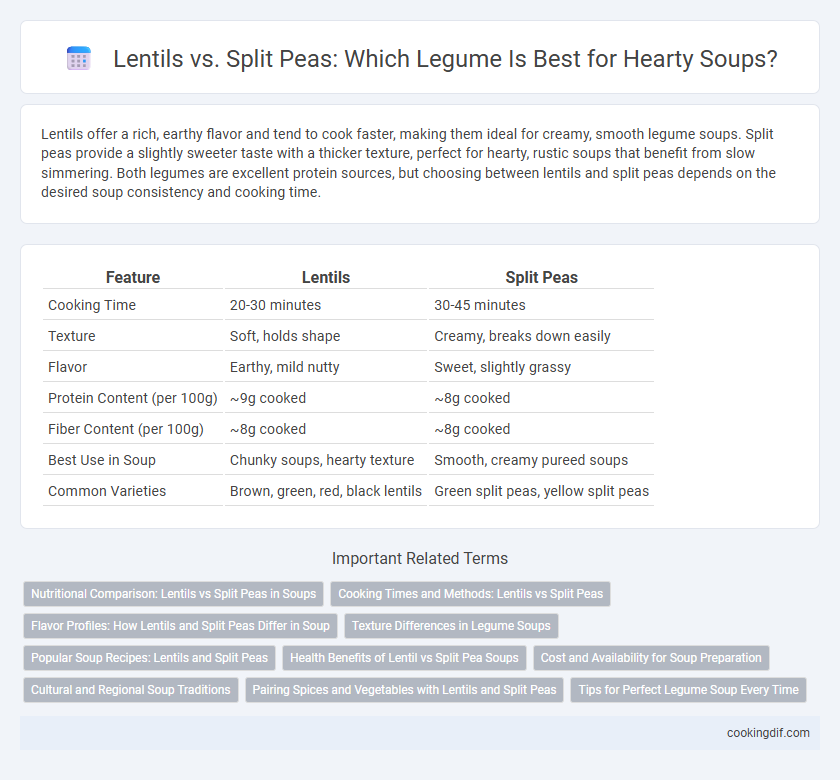Lentils offer a rich, earthy flavor and tend to cook faster, making them ideal for creamy, smooth legume soups. Split peas provide a slightly sweeter taste with a thicker texture, perfect for hearty, rustic soups that benefit from slow simmering. Both legumes are excellent protein sources, but choosing between lentils and split peas depends on the desired soup consistency and cooking time.
Table of Comparison
| Feature | Lentils | Split Peas |
|---|---|---|
| Cooking Time | 20-30 minutes | 30-45 minutes |
| Texture | Soft, holds shape | Creamy, breaks down easily |
| Flavor | Earthy, mild nutty | Sweet, slightly grassy |
| Protein Content (per 100g) | ~9g cooked | ~8g cooked |
| Fiber Content (per 100g) | ~8g cooked | ~8g cooked |
| Best Use in Soup | Chunky soups, hearty texture | Smooth, creamy pureed soups |
| Common Varieties | Brown, green, red, black lentils | Green split peas, yellow split peas |
Nutritional Comparison: Lentils vs Split Peas in Soups
Lentils in soups provide approximately 18 grams of protein and 8 grams of fiber per cooked cup, supporting muscle repair and digestive health, while split peas offer slightly more protein at 16 grams and an impressive 16 grams of fiber, enhancing satiety and gut function. Split peas contain higher levels of potassium and magnesium, essential for heart health and muscle function, whereas lentils are richer in folate and iron, vital for blood cell production and energy metabolism. Both legumes are low in fat and calories, making them nutrient-dense choices for legume soups focused on balanced nutrition and sustained energy release.
Cooking Times and Methods: Lentils vs Split Peas
Lentils typically cook faster than split peas, requiring about 15 to 30 minutes depending on the variety, while split peas need 30 to 45 minutes to become tender. Both legumes benefit from soaking, but split peas often cook well without pre-soaking, whereas red lentils cook quickly without soaking. Using a pressure cooker can significantly reduce cooking times for both, with lentils softening in around 5 to 10 minutes and split peas in 10 to 15 minutes.
Flavor Profiles: How Lentils and Split Peas Differ in Soup
Lentils in soup offer a mild, earthy flavor with a slightly peppery undertone that enhances savory dishes, while split peas provide a sweeter, starchier taste with a creamy texture when cooked. Red and green lentils tend to break down quickly, thickening the soup without overpowering other ingredients, contrasting with split peas, which create a denser, velvety base ideal for hearty soups. Understanding these flavor profiles helps in selecting the right legume to complement spices, herbs, and other soup components.
Texture Differences in Legume Soups
Lentils in legume soups soften quickly, offering a creamy texture that blends smoothly into the broth, enhancing the soup's richness. Split peas maintain a denser, slightly grainy texture even after prolonged cooking, providing a hearty, rustic mouthfeel ideal for thick soups. These textural differences influence soup consistency and mouthfeel, with lentils yielding a velvety finish while split peas add substantial body.
Popular Soup Recipes: Lentils and Split Peas
Lentils and split peas are staple ingredients in popular legume soups, each offering distinct textures and flavors that enhance recipes like Indian dal and classic split pea soup. Lentils cook quickly and provide a creamy texture with a slightly peppery taste, making them ideal for spiced, hearty soups packed with vegetables and herbs. Split peas, commonly used in traditional pea soup, yield a thicker, smoother consistency and a mildly sweet flavor, perfect for slow-simmered recipes featuring ham or smoky spices.
Health Benefits of Lentil vs Split Pea Soups
Lentil soups offer a higher protein content and are rich in iron and folate, supporting muscle repair and red blood cell production. Split pea soups contain more fiber, promoting digestive health and sustained energy levels by stabilizing blood sugar. Both legumes provide essential vitamins and antioxidants, but lentils are preferred for cardiovascular benefits while split peas are ideal for improving gut health.
Cost and Availability for Soup Preparation
Lentils offer a cost-effective option for legume soups, typically priced lower than split peas due to widespread cultivation and high demand. Split peas, while slightly more expensive, provide consistent availability in most grocery stores and specialty food markets, especially in dried form. Both legumes boast long shelf lives, but lentils often yield greater affordability without sacrificing nutritional value, making them ideal for budget-conscious soup preparations.
Cultural and Regional Soup Traditions
Lentils are a staple ingredient in Middle Eastern and Indian soup traditions, where they create rich, spiced dishes like Indian dal and Lebanese mujaddara. Split peas are more commonly used in European and North American soups, such as Scandinavian yellow pea soup and classic split pea soup in the United States and Canada. The choice between lentils and split peas reflects regional availability and culinary customs, shaping the texture and flavor profiles distinctive to each culture's legume soups.
Pairing Spices and Vegetables with Lentils and Split Peas
Lentils pair exceptionally well with earthy spices like cumin, coriander, and turmeric, enhancing their naturally nutty flavor, while vegetables such as carrots, tomatoes, and spinach complement their texture and add brightness. Split peas benefit from robust herbs like thyme, bay leaves, and rosemary, which deepen the soup's savory profile, and pair nicely with starchy vegetables like potatoes, leeks, and celery for a hearty consistency. Both legumes absorb bold spices and aromatic vegetables effectively, making them versatile bases for richly flavored legume soups.
Tips for Perfect Legume Soup Every Time
For a perfect legume soup every time, soak lentils and split peas for at least 4 hours to reduce cooking time and ensure even texture. Use low-sodium broth and aromatics like garlic, thyme, and bay leaves to enhance flavor without overpowering the natural earthiness of the legumes. Stir soup occasionally and cook on low heat to avoid splitting peas or overcooking lentils, which affects the soup's consistency and mouthfeel.
Lentils vs Split peas for legume soups Infographic

 cookingdif.com
cookingdif.com